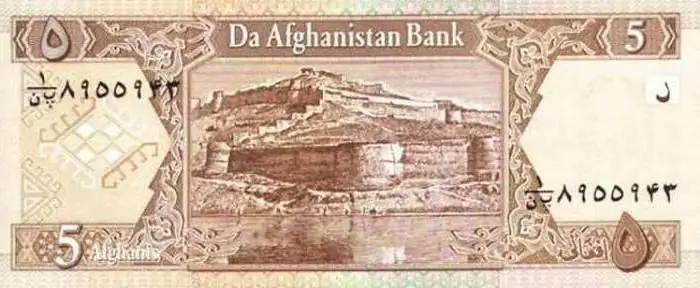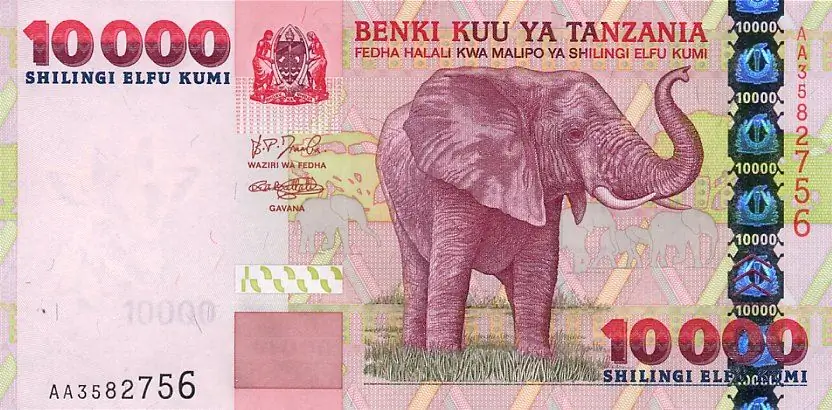2026 Author: Howard Calhoun | [email protected]. Last modified: 2025-01-24 13:10:45
In Tanzania, the currency that is used as a means of payment is called the Tanzanian shilling. There are 100 cents in one shilling. The international letter designation consists of a code in the form TZS. The currency is not in demand among stock speculators due to its instability.
Description
Few people know what currency is in Tanzania, because it does not play a big role in the global financial system. Today, paper banknotes issued according to the model of 2003 and 2010 are in circulation in the country. Their face value ranges from 500 to 10,000 shillings.

Coins made of metal are issued in denominations from 5 cents to 200 shillings. The watermark on the currency of Tanzania is depicted on all denominations. On the money of the 2003 sample, it is presented in the form of a giraffe's head, and on the banknotes issued in 2010, Julius Nyerere and the denomination are depicted.
The shilling watermark - on the currency of Tanzania in the form of a portrait of D. Nyerere is quite justified. This is the first president of sovereign Tanzania, as well as an active fighter forindependence of the country in the 60s. The country honors his achievements and contribution to the formation of the state.
History of currency
The new sovereign state of Tanzania officially introduced the currency (shilling) into circulation on June 14, 1966. From that moment on, East African shillings, which were previously used in the British colonies in this region, ceased to be used in the country.
Banknotes issued in 2003 began to be used in February of the same year, and money of the 2010 model was officially introduced into circulation in January 2011
Coins
Initially, in 1966, metal coins in denominations of 5, 20 and 50 cents, as well as 1 shilling, were introduced into circulation in the country. Made from copper-nickel alloy, bronze or nickel.

In 1972, the 5 shilling bill was replaced by a coin of the same value. Since 1987, 50 cents and 1 shilling have been made from steel. In 1994, 100 shillings in brass, then in 1996, 50 shillings, and since 1998, 200 in the same material.
Banknotes
In 1966, the first paper notes were introduced in denominations of 5, 10, 20, 100 Tanzanian shillings. They replaced the retired colonial East African shillings. Some larger bills followed.
At the moment, paper banknotes of 500, 1000, 2000, 5000 and 10,000, which were issued in 2003 and 2010, are officially used as means of payment. Although bank notesreleased on the model of 2003, are still used on a par with newer ones, they are gradually withdrawn from circulation.
Older money is no longer used as means of payment, but can be exchanged at a bank at any time. The design of banknotes is quite typical for this region. They depict significant animals (lion, rhinoceros and elephant) living on the territory of the state, people and objects of architecture.
The exchange rate of Tanzania against the ruble and other monetary units
As of the end of July 2018, the exchange rate of the shilling used in Tanzania against the Russian ruble is approximately 0.027 RUR. That is, for one ruble you can get approximately 35 shillings. In addition, due to the constant jumps in the rates of both currencies, this ratio is constantly changing.
When comparing the shilling with the European currency, the exchange rate will be less than 0, 0004 EUR. That is, for one euro you can get approximately 2700 Tanzanian monetary units.

Almost the same situation will be if we compare the exchange rate of Tanzania against the US dollar. So, for one dollar you can get almost 2300 TZS. Accordingly, for one shilling they will give a little more than 0, 0004 USD.
Same situation when compared to the British pound, Australian or Canadian dollars.
In Tanzania, the exchange rate is extremely unstable and constantly changing. In addition, it is one of the cheapest monetary units in the world. Such a low exchange rate is associated with a very weak economic development of the country. Standard of living and the state of the economyare in a deplorable state.
Exchange transactions
The easiest way to exchange in Tanzania is the currency of the United States and the European Union. This can be done at airports, large hotels and restaurants. There are also official exchange offices. However, the exchange rate in official financial enterprises is not the most favorable. Therefore, many tourists exchange money with "street" money changers, who offer more favorable conditions.
But one should not expect a huge benefit from such an exchange, since the difference in rates is not too great. However, this method is sometimes not only profitable, but also more convenient to use. In Tanzania, you can not exchange currency everywhere. This is especially true for non-tourist cities, where there may not be a necessary exchanger at all.
Cashless payment
Tanzania is one of the poorest and least developed countries in the world, so it is not particularly necessary to count on cashless payments. Most of the country's residents do not even have a bank account, so terminals for paying for purchases or services with a card are installed only in large restaurants, hotels, shopping centers.

Also in tourist cities, this issue is not so acute, but you still need to always have enough cash with you so as not to be in a difficult situation.
Due to the rapid development of the tourism sector, the state is raising and developing its economy, and at the same time, the number of places where you can pay for goods and services with a bank plastic card is increasing.
Perhaps, to say that using mobile applications for contactless payment, like Android Pay or Apple Pay, will not work at all. There are so few places where you can do this that you can literally count them on the fingers.
Withdrawing money from an ATM
In resort or large cities, you can find an ATM or a bank branch, although in comparison with European countries there are catastrophically few of them. In addition, not every bank works with foreign currency. And if they do, then the commissions for the operation will be quite high.
However, in the absence of an alternative, you can use this method. In this case, it is recommended to withdraw a large amount at once, so as not to pay a commission once again. To reduce the fee, try to find an ATM machine of a foreign financial institution. They are usually located in large hotels, restaurants and international airports. But there are quite a few of them in the country.

Therefore, it is better to prepare in advance for the fact that you will need a lot of cash and exchange it while in your home country. This way you can save on commissions. However, check in advance whether there are restrictions in the customs legislation of Tanzania on the currency, or rather its import, and what is its size.
Some Features
Due to the unstable and low exchange rate of the national currency in the country, US dollars are used almost on a par with it. Therefore, you can safely pay with them. In hotels, large supermarkets, restaurants andIn shopping centers, the cost of goods is often indicated in dollars, so that it is easier for foreigners to understand what the real price is. However, this does not mean that in such places you can only pay in dollars. You can easily pay for the purchase with local money at the official rate.
Other banknotes (euro, pounds, rubles, etc.) are of no interest to the local population, so there is practically no point in taking them on a trip. The same goes for credit cards, which will be of little use in this country.
They are not only practically pointless to take with you, but also dangerous. There is a high level of fraud with plastic cards of banks in the country. Anywhere you can be deceived and steal all the money from the card account. If you are not ready to take risks, then it is better to use a credit card only in trusted and reliable places.

Carrying a lot of cash is also not recommended due to the high crime rate. Also, do not openly demonstrate the amount of money or walk alone in the dark. Major resorts are considered relatively safe for foreigners.
Conclusion
Tanzania, although an underdeveloped country, but the tourism sector here is experiencing a real "boom". Hundreds of thousands and even millions of tourists come here every year. As a result, tourism infrastructure is developing rapidly. New hotels, resort areas, shopping centers, well-groomed beaches, etc. appear.
People come here not only for the sake of sandy beaches, the azure sea and the hot sun, but also to admirethe beautiful nature of this region. Lions, leopards, elephants, giraffes, rhinos, buffaloes, hippos and many other exotic animals live in the savannahs of this country, which a European person can only see in a zoo or on a TV screen. Here you can watch them with your own eyes.

Interest in Tanzania as a tourist country is increasing every year. Moreover, many Russians also began to give preference to this particular country when choosing a vacation destination. With such a pace, in 5-10 years it will turn into a real "Mecca" for foreign tourists and can easily squeeze out Egypt. Tanzania has all the data (nature, climate, ocean, low cost, etc.). The main thing is to use this resource correctly.
With the growth of tourist demand, interest in the national currency of this East African state is rapidly increasing.
Recommended:
What is the difference between the cadastral value and the inventory value? Determination of the cadastral value

Recently real estate has been valued in a new way. The cadastral value was introduced, providing for other principles for calculating the value of objects and as close as possible to the market price. At the same time, the innovation led to an increase in the tax burden. The article describes how the cadastral value differs from the inventory value and how it is calculated
Albanian currency lek. History of creation, design of coins and banknotes

The Albanian currency lek got its name as a result of the abbreviation of the name of the legendary commander of antiquity Alexander the Great. In a similar way, the people of this country decided to declare to the whole world their involvement in this outstanding historical figure. Nevertheless, until 1926 the Albanian state did not have its own banknotes. The currency of Austria-Hungary, France and Italy was used on the territory of this country
1982 bonds: history of the loan, conditions, terms, face and actual value and what they were intended for

What are bonds? Why is there interest in 1982 bonds again? For what, in what circulation were they released? What were the terms of the government loan? The fate of OGVVZ after the collapse of the USSR. What could they be exchanged for? How much cash was offered? The situation with 1982 bonds in 2018 - how can you deal with them today? The decision of the Ministry of Finance regarding the pre-reform savings of citizens
The currency of Afghanistan: the history of the currency. Curious information about the currency

Afghan currency Afghani has almost a century of history, which will be discussed in this material
Banknote "5000 rubles": the history of appearance and protection. How to recognize a fake banknote "5000 rubles"

The banknote "5000 rubles" is perhaps one of the largest banknotes of modern Russia. It is not so rare, but the trouble is that not every Russian can boast of at least a minimal knowledge of the signs of the authenticity of banknotes of this denomination

